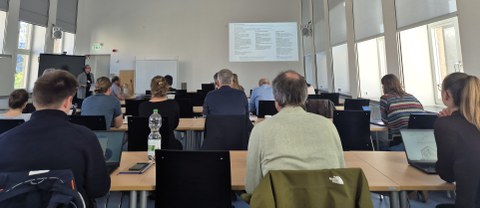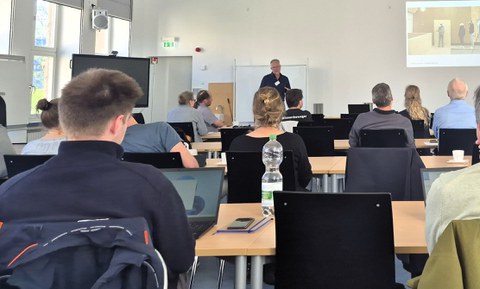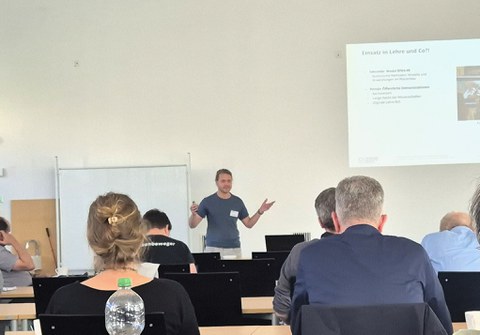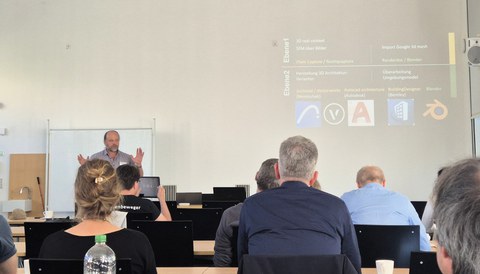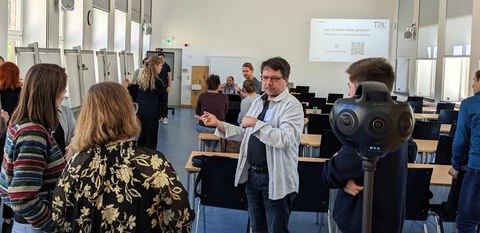Review: XR
The seventh networking and digital teaching workshop on the topic of university teaching meets XR took place on 09.05.2025.
Table of contents
Introduction to virtual realities in teaching
Silke Molch from the Digital Teaching team gave an introduction to virtual realities, clarified the differences between the various types of virtual realities and showed which equipment and planning steps are important.
To the slide set:
Silke Molch: Introduction to virtual realities in teaching
The most important statements:
- Physical reality, which is perceived with the five senses, can be partially reproduced digitally:
- Augmented reality (AR) refers to the technology for integrating digital elements into the user's existing real environment, where interactions can take place using gestures, voice control and touch.
- Virtual reality (VR) can be used to create immersive experiences through the digital simulation of virtual spaces without a direct link to the user's physical environment.
- Augmented virtuality (AV) is the technology for integrating physical components (live transmission) into virtual environments.
- Mixed reality (MR) is the combination of augmented reality and virtual reality.
- Extended reality (XR) is the collective term for all immersive technologies.
- Virtual worlds can be perceived with the help of VR or MR-AR glasses, video walls, projection domes (fulldome, cave) as well as VR gloves and haptic clothing.
- In order to integrate virtual reality into teaching, the purpose and requirements should first be clarified so that the technology can then be selected, the content created, programming carried out if necessary, tests performed and use in teaching can begin.
Real room capture and virtual tours with a 360-degree camera
Maik Jähne, employee of the Saxon State and University Library (SLUB), is in charge of the SLUB Makerspace for VR technology and showed possibilities for recording virtual tours with 360-degree cameras at the workshop.
To the slide set:
Maik Jähne: Capturing real space and virtual tours with a 360-degree camera
The most important statements:
- The SLUB Makerspace provides access to modern technology to create virtual worlds. Cameras, VR glasses and powerful laptops can be borrowed for up to 4 weeks.
- With the help of a 360-degree camera, real rooms, for example laboratories, can be photographed from different perspectives in order to later compile them into digital tours or prepare them for virtual laboratory experiments.
- Easy-to-use special software for creating 360-degree tours, including the storage of additional information or links, can also be borrowed from the SLUB Makerspace.
- Information and reservation at: .
The Hybrid Spaces project
Prof. Henning Haupt, Chair of Foundations in Art and Architecture, explained the Hybrid Spaces project, in which real and virtual realities were combined. One of the aims was to make possible architectural changes tangible.
To the slide set:
Prof. Henning Haupt: Hybrid Spaces
The most important statements:
- The Hybrid Spaces project is made up of four sub-projects: Sound Space Body, Hybrid Spaces, Occupying Color and Space, Strategies of Lightweight Construction.
- The focus of the overall project is on the combination of built architecture and augmented reality. Physical and digital design are combined and made tangible with the help of VR glasses.
Experience a dam from the inside - building inspection with VR
Lars Backhaus from the Institute of Hydraulic Engineering and Technical Hydromechanics reported on his experience of creating a virtual tour of the Lauenstein flood retention basin and using it in teaching.
To the slide set:
Lars Backhaus: VR tour of the Lauenstein flood retention basin
The most important statements:
- Although specialist excursions could not take place due to the Corona pandemic, the interior of the Lauenstein dam was to be made accessible to students for teaching purposes. To this end, 360-degree images were taken, combined with 2D site plans and various interactive elements were added.
- Students can view the structure on a screen or using VR glasses and navigate using gestures with their hands.
- The product is now used in teaching, but is also used in public demonstrations such as the Dresden Science Night or in Student Marketing.
Design and variant development in architecture with VR
Knuth Pietsch from the Chair of Landscape Architecture and Design demonstrated the methods used by landscape architecture students to create and visualize designs.
The most important statements:
- Virtual machines from the ZIH with special graphics equipment are used so that students can use sophisticated software. Students and lecturers can access these resources using their conventional computer.
- This method is used in project work with CAD as well as for visualization and animation tasks. The software used includes Archicad Vectorworks, Autocad Architecture, Building Designer, Blender, LumentRT, Lumion and Twinmotion.
- Thanks to the high computing power, complete models with good animations, texturing and lighting scenarios can be created and displayed in real time.
After the plenary session, there was time to take a look at the virtual worlds created, try out the technology and be inspired in discussions for possible teaching applications.

